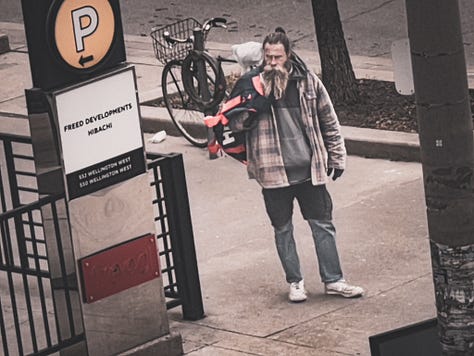how far the man
how distant the subject
TL; DR: a man, in parts
Steven Reich wrote “Violin Phase”, where a single set of repeating notes is sequentially stacked over itself many times in out-of-synch layers. What begins as a minimalistic phrase of notes evolves into something monumental over time. Because of phasing, the composition is sometimes messy, sometimes resolved; is at various times cacophonous or glorious; is both meandering and mystical, repetitious and hypnotic. A finite phrase hints at the infinite. When “Violin Phase” plays, you start out hearing, but end up listening.






David Hockney did a series of polaroid collages, compositions where multiple photographs of portions of the subject (one place or person) were taken from different distances and perspectives, then massed together and presented as a single image. So you see the entire room, or person, simultaneously from a multiplicity of view points (closer, farther, from below or the side). But you are also viewing it from various times, because the photographs were all taken at different moments.
Michael Snow did a long series called “The Walking Woman”, where he repeated the same silhouette of a woman across dozens of different media, scales, and settings, over years. Each individual image becomes more interesting because of its existence within the broader context of the entire body of work.
Andy Warhol made an 8 hour long durational film of the Empire State building from a single point of view, a stationary camera placed at a fixed location. He stated that the purpose of the film was "to see time go by”.
These photos are a single portrait of a man. Like “Violin Phase” and “Walking Woman”, they are “temporal variations on the original”, iterations that accrete meaning. Like the Composite Polaroids, the images are of one subject seen from slightly different angles, at varying times. Like “Empire”, it is a durational work of a single subject, made from a fixed location, that shows time passing via subtle changes around the protagonist (weather, graffiti, construction, detritus), and on him (his clothes, his hair).
He always passed by around sunset, always going the same direction. I never saw him interact with anyone. I watched his weight change, his posture hunch, his gait slow, his face weather even more. One day he stopped just before the crosswalk at a chromed hotel sign (which many people use as a convenient mirror — girls put on lipstick, guys pat their hair, everybody pre-selfie primps). He stared intensely at his own reflection, not moving, no grooming. Sunlight blasted a rectangle of light onto his face, and I watched as he just kept peering at himself. It was an odd moment because it felt like we were both studying a stranger.
I never did try to get to know him. How far the man, how distant the subject? He was only thirty feet away, for over a year. He passed by nearly every day. I could have run down the stairs, introduced myself, found out his name. Find out what he did an hour before passing by, what he does an hour after. Maybe as a result he’d look up at the window the next time he passed, smile and wave…
The building from where The Window project was shot is being torn down, so I’ve moved, but I hope the man with the beard is still healthy and continuing on his journeys. In my imagination he still passes by, and I’m still photographing him, each image another note or phrase added to his infinite song.
NOTES:
CLICK HERE to see bigger individual images in the grid portrait at top
More The Window words & images HERE
Speaking of Reich, here’s a soundtrack suitable for the above images: “Uneunoia”, a downtempo instrumental made from a phrase that evolves across instruments, sonic clarity, and spatial placement (from my music-making days back in the day as K.I.A, and as Shinjuku Zulu)







